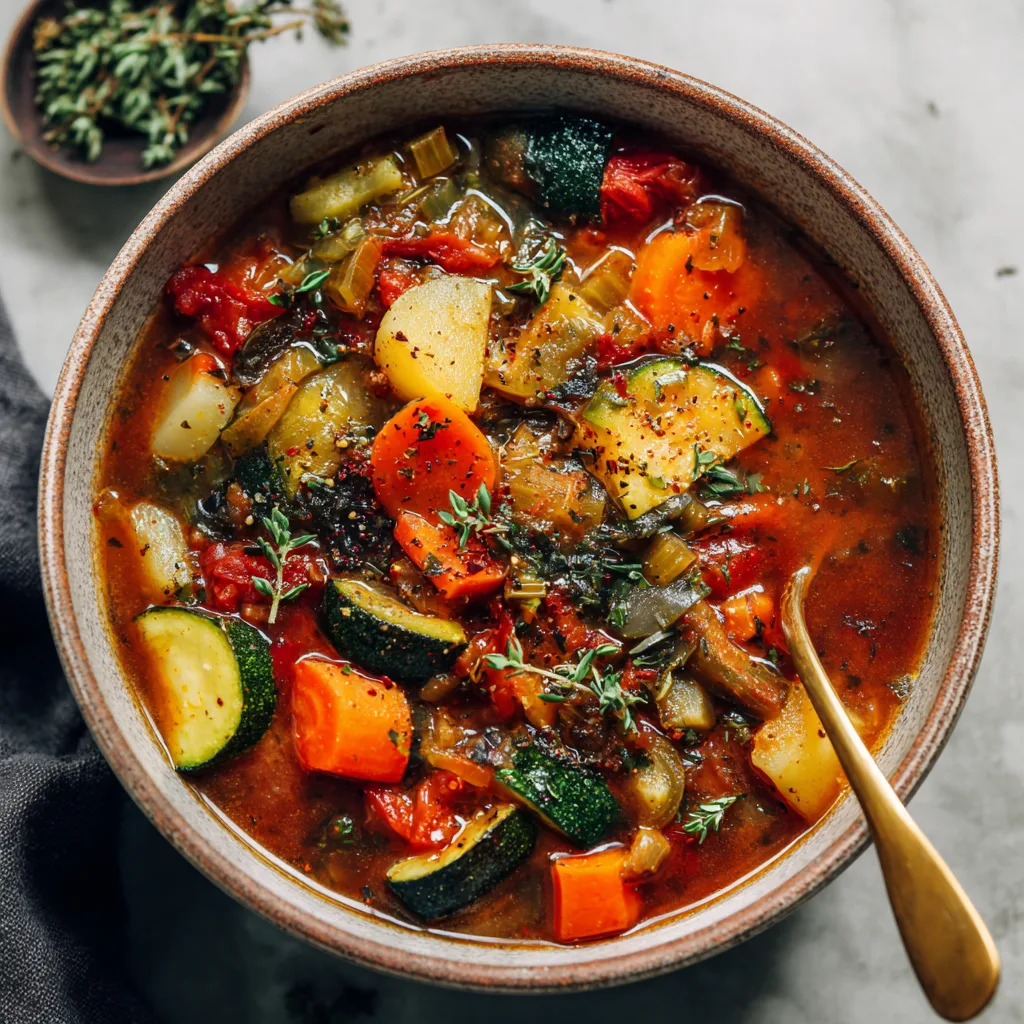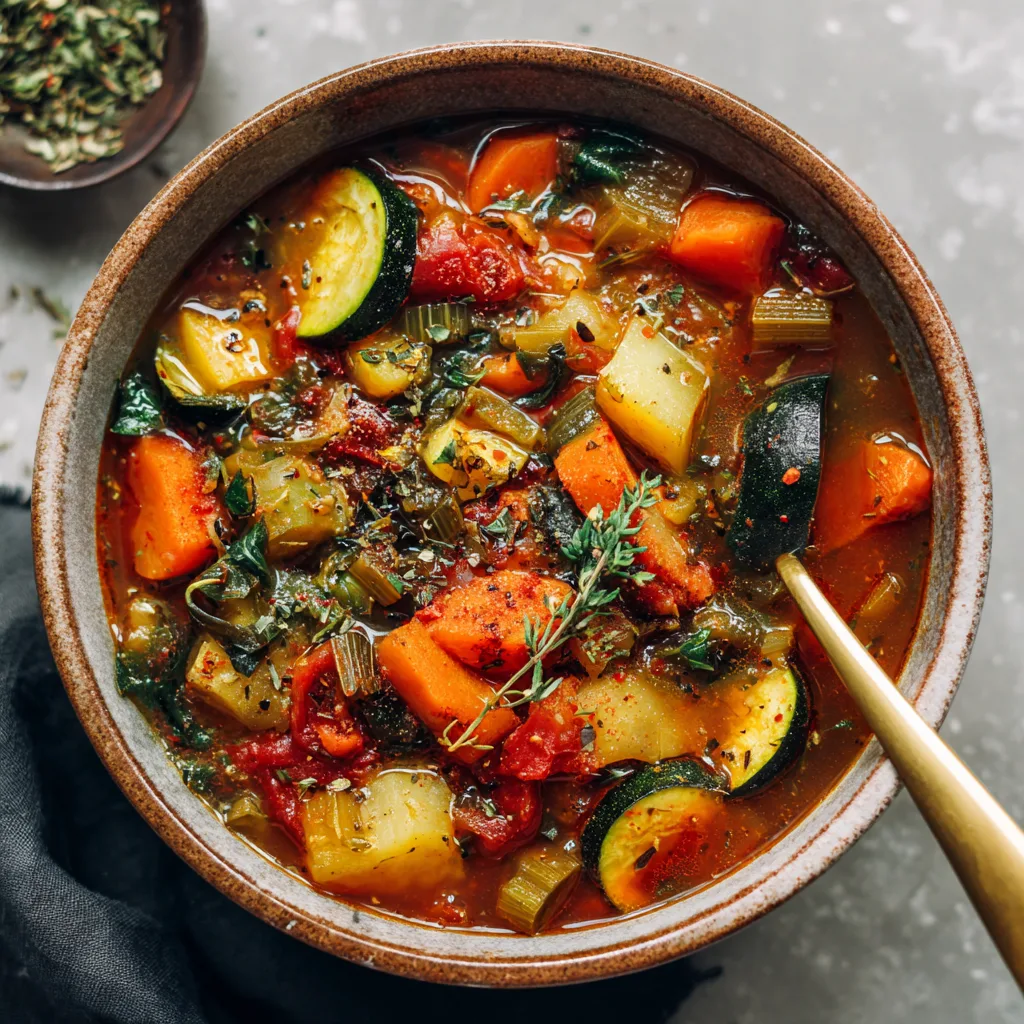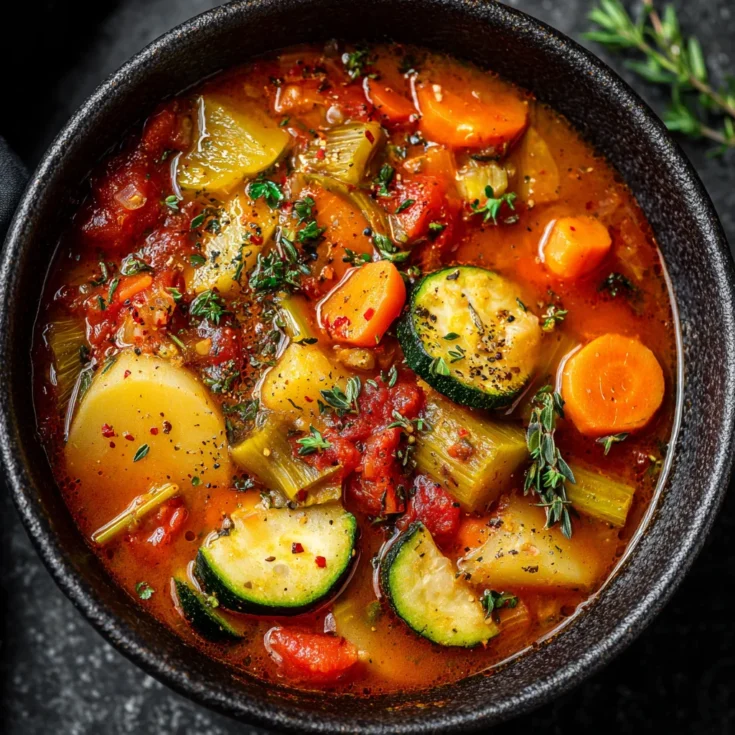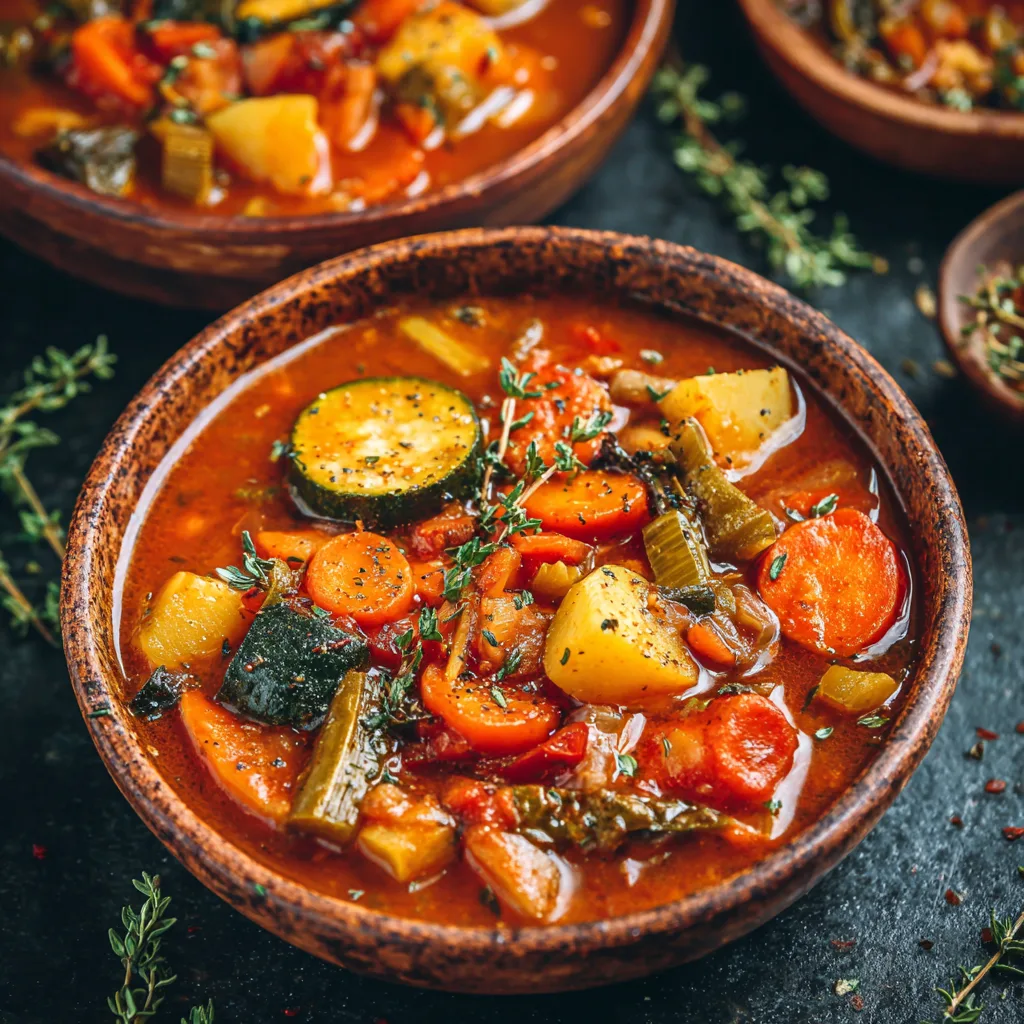What Makes It Hearty & Nourishing
A hearty stew brings more than warmth—it delivers substance. The word “hearty” signals depth, fullness, and satisfaction. It’s a meal that doesn’t leave you hungry an hour later. What creates this rich effect in a vegetable stew?
It starts with fiber-rich beans, chunky root vegetables, and starchy grains. Think carrots, potatoes, lentils, and barley. Mushrooms add a meaty bite without the meat, and their umami flavor deepens the taste.
These ingredients turn a simple stew into a complete, filling meal. They bring texture, balance, and nutrition all in one pot. This isn’t a thin broth—it’s thick, savory, and deeply comforting. Food lovers across platforms—from California Grown to Our Salty Kitchen—agree: when built with care, a vegetable stew can outshine its meat-filled cousins.
Benefits of a Veggie-Based Stew
Plant-based stews are more than trendy—they’re smart. Packed with vegetables, legumes, and herbs, they offer essential nutrients and powerful antioxidants. A single bowl can support heart health, aid digestion, and boost immunity.
They’re also inclusive. Whether you’re vegetarian, vegan, or gluten-free, a well-crafted vegetable stew fits your diet with ease. Recipes from Her Wholesome Kitchen highlight this flexibility, making the dish both nourishing and accessible.
Plus, without meat or dairy, these stews are easier on the environment. You’re making a healthy choice for your body and the planet.
One‑Pot Wonder for Busy Homes
In a fast-paced world, the fewer dishes, the better. That’s where the one-pot advantage shines. With a hearty vegetable stew, you cook everything in a single pot—no extra pans, no mess.
Meal-prepping becomes effortless. Make a big batch and enjoy it for days. Sites like Vegan Gluten Free Life and My Pure Plants show how this stew adapts to your schedule without sacrificing flavor.
It’s cozy, healthy, and practical—all from one pot.

Core Ingredients & Variations for Hearty Vegetable Stew
Mirepoix (Onion, Carrot, Celery) – The Aromatic Foundation
Every great vegetable stew begins with mirepoix. This classic trio of onion, carrot, and celery creates the flavor foundation. The ideal ratio is 2 parts onion to 1 part each carrot and celery. Sautéed until soft and fragrant, this blend forms the base that ties the whole stew together.
Onions bring sweetness and depth, while carrots offer a touch of natural sugar and color. Celery adds earthiness and aroma. Together, they balance and enhance every spoonful. According to many home cooks and community tips on Reddit, a well-cooked mirepoix is the key to an unforgettable vegetable stew.
Root Vegetables & Potatoes – Substance and Softness
Root vegetables build texture. Potatoes, turnips, and parsnips absorb broth while softening just enough to melt in your mouth. They give body to the stew and make it filling. Choose starchy varieties like Russets for thickness or Yukon Golds for a creamy bite.
Balance the mix so each vegetable complements the others. The variety of textures makes every bite unique.
Mushrooms & Umami Boosters – Flavorful Depth
Mushrooms add rich, savory notes that mimic the flavor of meat. When browned properly, they create a deep umami taste that anchors the stew. Cremini, portobello, or shiitake mushrooms work best.
Umami boosters like tomato paste and tamari elevate the flavor. They add a subtle boldness that balances the earthiness of the vegetables. These small additions make a big difference.
Beans, Grains & Legumes – True Hearty Fillers
Beans, lentils, and grains make your stew more than just a side. They bring protein, fiber, and serious staying power. Use white beans, chickpeas, or green lentils for texture. Barley and split peas thicken the broth naturally while boosting nutrition.
Sources like Wikipedia, Allrecipes, and Reddit highlight how these plant-based additions make the stew a full, satisfying meal. They’re essential for keeping the dish both hearty and healthy.
Broths, Herbs & Seasonings – Layers of Flavor
Use low-sodium vegetable broth as your base. It allows other flavors to shine. Tomato paste adds richness and body. Herbs like thyme, rosemary, and bay leaf infuse the stew with comfort and warmth.
Avoid wine or alcohol-based ingredients. Instead, build depth with slow cooking and bold seasonings like smoked paprika or garlic powder. Don’t forget salt and pepper—they bring everything together.
Popular Variations from Top Recipes
Vegan & Gluten‑Free Friendly Options
Hearty vegetable stew is naturally vegan and easily adapted to be gluten-free. Recipes from sites like Yup It’s Vegan and Vegan Gluten Free Life often feature gluten-free thickeners like cornstarch or arrowroot.
These versions use plant-based broth, skip processed additives, and rely on whole foods. It’s a meal everyone can enjoy, regardless of dietary needs.
One‑Pot or Crockpot Options for Convenience
Want hands-off cooking? Crockpots and slow cookers make meal prep easy. Add all your ingredients, set the timer, and let the stew simmer to perfection.
Sites like California Grown, Feel Good Foodie, and Vegan Gluten Free Life show how to adapt any hearty stew recipe into a set-it-and-forget-it version. Perfect for busy weeknights or batch cooking.
Rich Variants Without Wine
Some recipes add intensity using unique ingredients like dark chocolate or tomato concentrate. My Pure Plants recommends these for adding richness without alcohol.
A teaspoon of unsweetened cocoa powder deepens the flavor naturally and enhances savory notes. It’s a creative twist that keeps your stew alcohol-free yet full-bodied.
Grain Fillers for Extra Comfort
Want a stew that feels like a complete meal? Add rice, wild rice, or even quinoa. These grains soak up broth and bulk up the dish beautifully.
California Grown and other trusted sources highlight how rice adds chewiness and helps balance the vegetables’ softness. It’s a delicious way to stretch your stew further.
Cooking Techniques & Tips for the Perfect Hearty Vegetable Stew
Sauté & Browning – Building the Flavor Base
Start by heating oil in a large pot over medium heat. Add chopped onions, carrots, and celery. Cook until soft and golden. This process unlocks their natural sweetness.
Next, stir in the mushrooms. Let them brown without stirring too often. This step is key. It brings a deep, rich flavor that forms the foundation of your stew.
Browning isn’t just about color—it’s about taste. The savory notes created here can’t be added later. Take your time. Let the vegetables develop that delicious golden crust before moving forward.
Deglazing & Layering Flavors – Boost Without Wine
Once the vegetables are browned, scrape up the flavorful bits from the bottom of the pot. This is called deglazing. Instead of using wine, pour in a splash of vegetable broth.
Add tomato paste and stir until it darkens slightly. This step builds richness and deepens the stew’s color. Now, pour in the rest of the broth and stir to combine.
Layer your seasonings here. Add thyme, bay leaves, garlic, and smoked paprika. Each element adds depth and complexity without overpowering the natural flavors.
Simmering to Perfection – Don’t Overdo It
After combining all ingredients, reduce the heat and let the stew simmer gently. A low simmer ensures even cooking and prevents mushy vegetables.
Cover the pot, but leave a small gap to allow steam to escape. This concentrates flavor without breaking down your veggies. Stir occasionally to check texture.
Most hearty stews take 30 to 45 minutes to fully develop flavor. Taste as you go and adjust the seasoning before turning off the heat.
Thickeners: Cornstarch vs Beans – Simple Ways to Add Body
A thick stew feels more satisfying. You can thicken it naturally using two methods. The first: a slurry made from cornstarch and cool broth. Stir it in near the end, simmer for a few minutes, and watch the texture improve.
The second: use mashed beans. Remove a ladle of cooked beans from the stew, mash them, and stir them back in. This technique adds creaminess and extra nutrition.
Hurry The Food Up recommends combining both methods for a perfectly balanced texture. Use these tools to control consistency without overcooking your ingredients.
Expert Tips for Maximum Flavor
To bring your stew from good to great, follow these trusted tips:
Brown mushrooms deeply before adding broth. This adds bold, earthy flavor that mimics meat. As Vegan Gluten Free Life and Our Salty Kitchen suggest, don’t rush this step.
Use fresh herbs near the end of cooking. Dried herbs work early, but fresh ones should be stirred in last for the best aroma and impact.
Balance your seasoning. Taste the broth before simmering. Adjust salt, pepper, or acidity as needed. This keeps the flavor bright and layered.
Let it rest for 10 minutes after cooking. This allows flavors to meld and the stew to thicken naturally. It also makes the final taste deeper and more harmonious.
Best Ways to Serve Hearty Vegetable Stew
A great stew deserves an equally satisfying side. Serve your hearty vegetable stew with warm, crusty bread to soak up the rich broth. Garlic bread, whole grain rolls, or sourdough slices all pair beautifully.
Want to add more substance? Spoon the stew over fluffy rice, buttery noodles, or creamy polenta. These bases stretch the meal and add a comforting texture.
Toppings elevate the bowl. Fresh chopped parsley or thyme adds brightness. A dollop of plain yogurt offers a creamy contrast. As suggested by Yup It’s Vegan, toppings bring flavor, freshness, and even visual appeal to the final dish.
What to Pair With Hearty Vegetable Stew
While this stew is filling on its own, pairing it with light sides creates a balanced meal. Start with a simple green salad dressed in vinaigrette. The crispness offsets the warmth of the stew.
For more fiber, try quinoa, farro, or brown rice on the side. These grains complement the stew’s earthy tones and soak up the savory broth.
Crusty bread remains a top choice. Toasted or warm from the oven, it’s perfect for dipping and adds a satisfying crunch. If you’re serving guests, consider a bread basket with different types for variety.
For family dinners, roasted seasonal vegetables or a chilled bean salad offer nutrition without extra effort. These sides round out the meal without overpowering the stew.
Storage & Freezing Hacks for Leftover Vegetable Stew
One of the biggest perks of hearty vegetable stew is how well it stores. Let the stew cool completely before refrigerating. Store it in an airtight container and keep it in the fridge for 4 to 5 days.
Freezing is just as simple. Use freezer-safe containers or bags, leaving space for expansion. Label each batch with the date. It can last in the freezer for up to 3 months without losing flavor.
When reheating, always thaw frozen stew in the fridge overnight. For best results, warm it on the stovetop over medium heat. Add a splash of broth or water to restore its original texture.
Stews thicken as they sit, especially those with beans or grains. Adding liquid during reheating helps revive the consistency and flavor. As recommended by Our Salty Kitchen and Meg is Well, reheating slowly helps preserve both taste and structure.
Nutritional Highlights of Hearty Vegetable Stew
Hearty vegetable stew isn’t just comfort food—it’s a nutrient powerhouse. Each bowl delivers a satisfying mix of fiber, vitamins, and plant-based protein, all without added fats or fillers. Packed with carrots, leafy greens, legumes, and potatoes, this stew fuels your body while keeping your taste buds happy.
The high fiber content supports digestion and helps keep you full longer. You also get a variety of essential vitamins and minerals like potassium, iron, and vitamin C. Beans and lentils provide plant-based protein, making the dish more complete and energizing.
Thanks to whole, real ingredients, this stew is also low in fat and rich in antioxidants. Sites like Yup It’s Vegan and Vegan Gluten Free Life emphasize how this meal is both clean and balanced.
Best of all? It’s naturally nutrient-dense—so you feel full, satisfied, and nourished without eating excess calories. It’s health-forward food with cozy, homemade appeal.
Adapting to Diets
Vegan and Vegetarian Options – Always Plant-Based and Wholesome
Hearty vegetable stew is easy to make vegan or vegetarian. Simply use plant-based broth and skip any dairy or animal-based seasonings. For creaminess, add blended beans or plant milk instead of cream.
Sites like Her Wholesome Kitchen and Allrecipes show how to build flavor without relying on cheese or butter. Fresh herbs, garlic, and quality vegetables bring all the richness you need—no animal products required.
This makes it perfect for plant-based lifestyles or anyone seeking cleaner, lighter comfort meals.
Gluten-Free Friendly – Simple Swaps for Any Bowl
To make your vegetable stew gluten-free, just choose the right thickeners. Replace wheat flour with tapioca starch, arrowroot, or cornstarch. These options provide the same silky texture without gluten.
Use certified gluten-free broth and check all packaged ingredients. Our Salty Kitchen highlights this approach, offering gluten-free comfort without compromise.
It’s an easy switch—and one that keeps your stew inclusive for everyone at the table.
High-Protein or Low-Carb Variations – Power in Every Spoon
Need more protein or watching carbs? Hearty vegetable stew can do both. For a protein boost, add extra lentils, chickpeas, or white beans. You’ll increase protein without adding meat.
To reduce carbs, simply limit starchy vegetables like potatoes. Instead, use cauliflower, zucchini, or leafy greens. These swaps lower carbs while keeping flavor and satisfaction high.
This flexible approach lets you tailor your stew to your health goals—without sacrificing comfort or taste.

Frequently Asked Questions
How do I make vegetable stew more hearty?
To add heartiness, include ingredients that offer substance and protein. Barley, chickpeas, lentils, and mushrooms all deliver bold flavor and a meaty texture. You can also stir in cooked grains like rice or quinoa. These additions give the stew more body and make it a complete meal.
Can I make this gluten-free?
Yes. Swap out flour-based thickeners with gluten-free alternatives like tapioca starch or cornstarch. Always choose certified gluten-free broth and double-check spice blends. This ensures a safe, satisfying meal for those avoiding gluten.
How thick should a hearty stew be?
The perfect consistency is rich and spoon-coating—not watery. To achieve that, simmer the stew uncovered near the end to reduce excess liquid. You can also mash some of the beans or use a cornstarch slurry to help thicken the broth naturally.
What’s the best way to store and reheat leftovers?
Cool the stew completely before storing. It keeps in the fridge for 4 to 5 days and up to 6 months in the freezer. Reheat slowly on the stovetop, adding a splash of broth or water to restore the original texture. Stir gently to keep vegetables intact.
Hearty Vegetable Stew – Cozy, Healthy, and One-Pot

A thick, nutrient-rich veggie stew packed with root vegetables, mushrooms, beans, and aromatic herbs—perfect one-pot comfort food.
Ingredients
- Potatoes, diced
- Carrots, sliced
- Celery, chopped
- Onion, diced
- Garlic, minced
- Mushrooms, sliced
- Cooked beans or pearl barley
- Tomato paste
- Vegetable broth
- Dried herbs (thyme, bay leaf, rosemary)
- Olive oil
- Salt
- Pepper
- Optional: gluten-free thickener (cornstarch or tapioca)
Instructions
☐ Sauté mirepoix (onion, carrot, celery) in olive oil until soft
☐ Add mushrooms; brown until golden and reduced
☐ Stir in garlic and tomato paste; cook for 1 minute
☐ Deglaze with vegetable broth, scraping up browned bits
☐ Add root vegetables, beans or grains, remaining broth, and herbs
☐ Simmer covered for 45 minutes, stirring occasionally
☐ Thicken with cornstarch slurry or mashed beans as needed
☐ Adjust seasoning; simmer uncovered for 5 more minutes
☐ Let rest off heat for 10 minutes before serving
Notes


